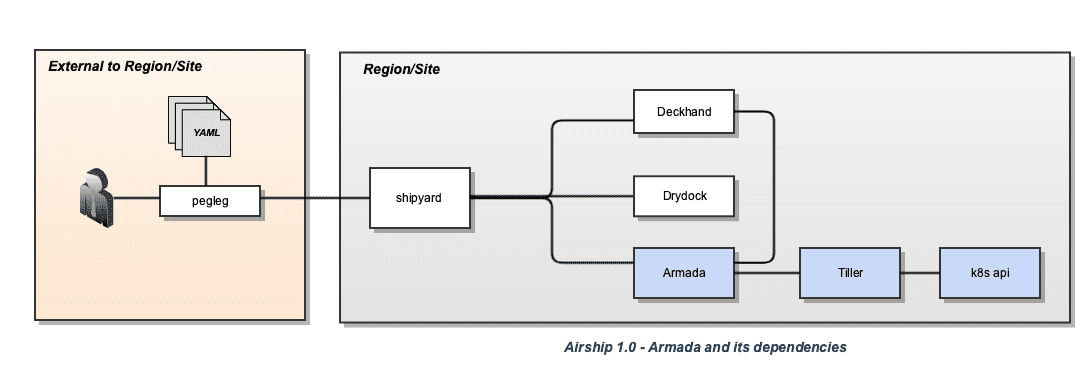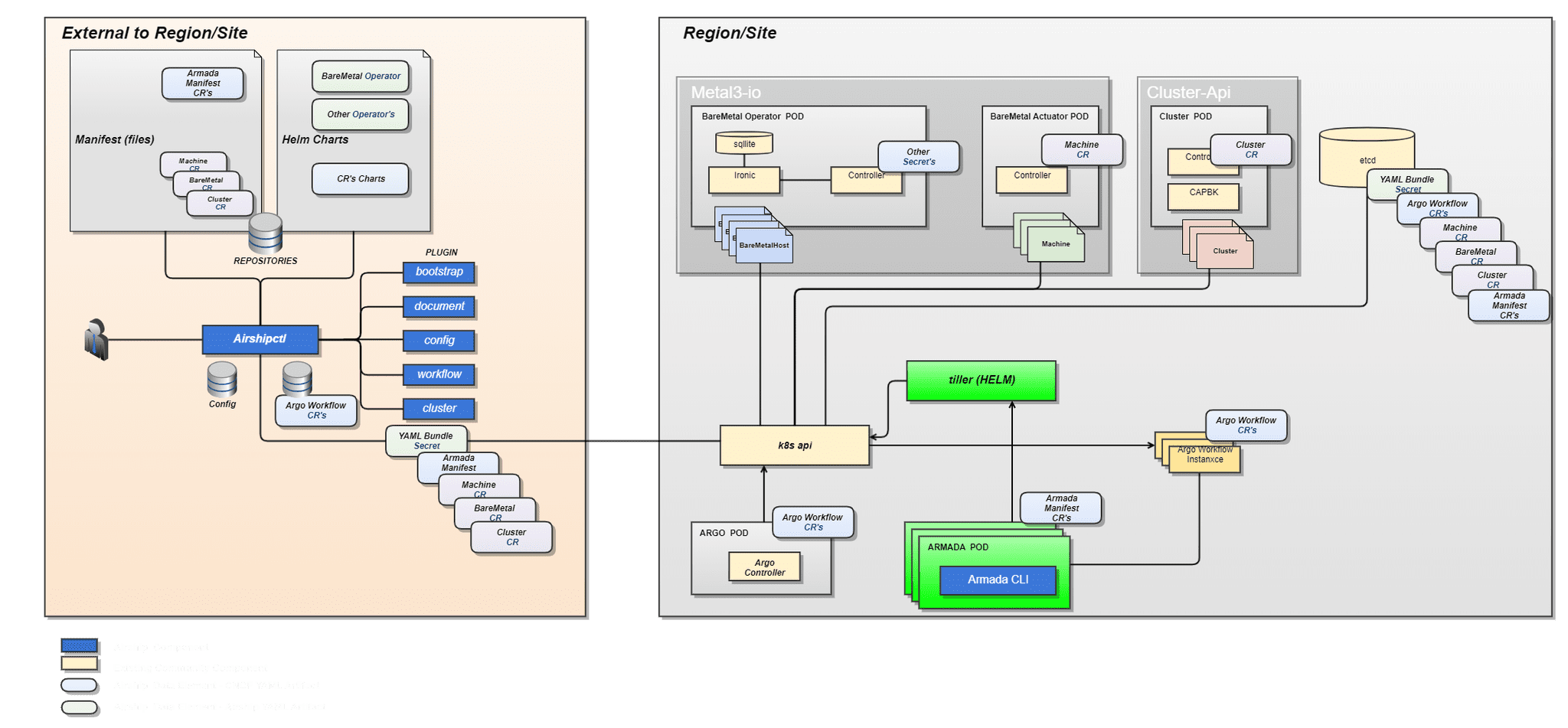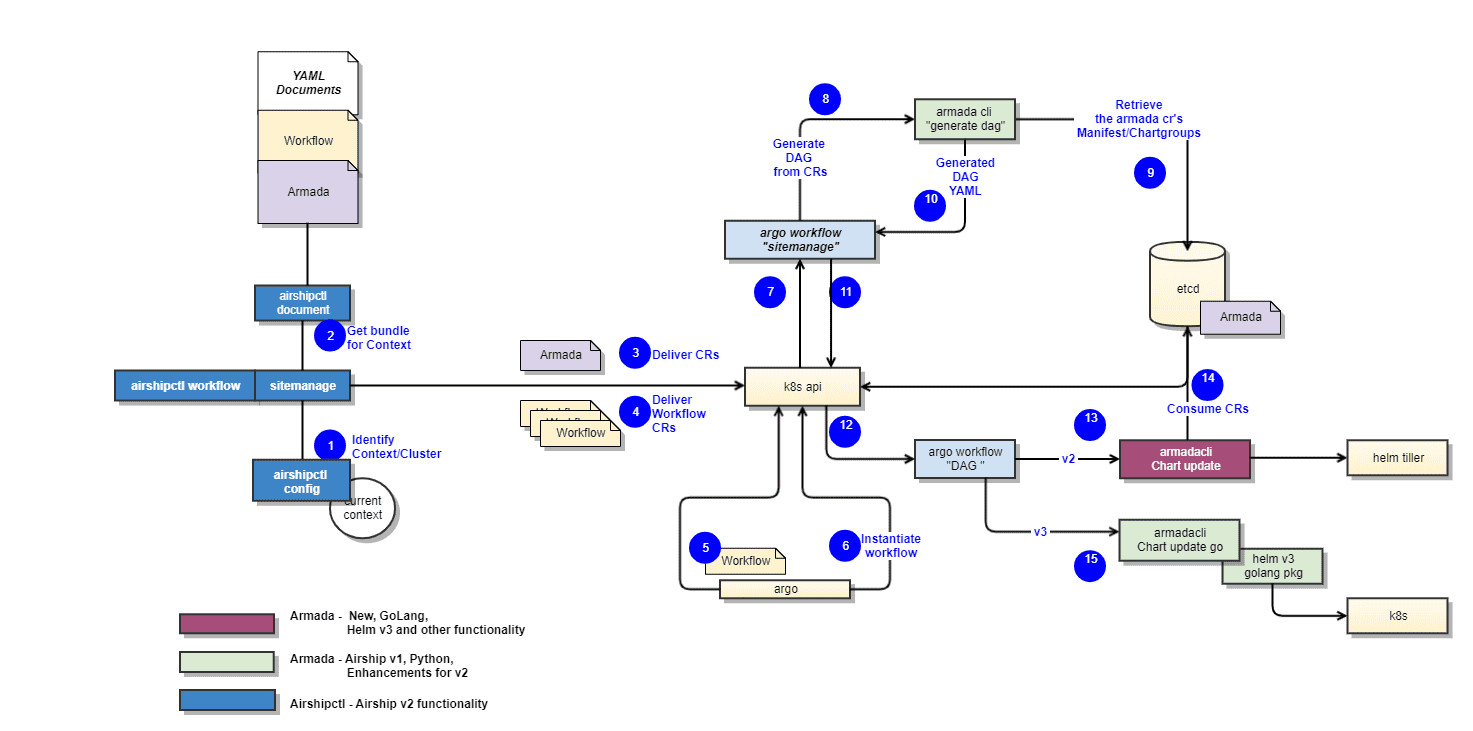Pre-Alpha Airship Blog Series 6 - Armada Growing Pains
UPDATE 03-August-2020: Airship 2.0 development spans multiple milestones. Upon completing the first major milestone, Alpha, the community took some time to reflect on lessons learned and how they impacted the direction and design of Airship 2.0. We have summarized these lessons learned and how the design has changed over time - including using different technologies and approaches. You can read more about these changes here: Airship 2.0 is Alpha - Lessons Learned. We recommend reviewing these changes before reading blogs marked as "Pre-Alpha."
Helm, the Kubernetes package manager, defined a mechanism to define and deploy a set of Kubernetes artifacts and their dependencies as a chart. The Helm CLI tool really targeted operators wishing to install a single helm chart at a time using the command line. What was missing for users like Airship was the ability to declaratively define several helm charts to install or upgrade and have that processed with a single command.
Armada provides a way to synchronize a Helm (Tiller) target with an operator’s intended state, consisting of several charts, dependencies, tests, and overrides using a single file or directory with a collection of Armada declarations. This allows operators to define many charts, potentially with different namespaces for those releases, and their overrides in a central place. With a single command, they can deploy and/or upgrade all of them where applicable. By arranging Charts into Chart Groups, Armada can also provide the ability to process installations and/or upgrades either serially or in parallel depending on the software needs.
Armada consists of three separate but complementary components:
- CLI component which interfaces directly with Tiller.
-
API component which services user requests through a WSGI server (which in turn communicates with the Tiller server) and provides the following additional functionality:
-
Engine component which processes Chart Groups and Charts, and provides the following features:
- Interacts with Kubernetes directly to perform basic pre and post-steps, such as removing completed or failed jobs, running backup jobs, or deleting resources that do not support upgrades.
- Running tests on helm charts and blocking until those complete or fail.
- Fetching chart sources from a variety of locations, such as remote git repositories and specific tags and/or branches, and tarball URLs.
- Blocking on Chart Readiness (wait until resources of a chart all become ready before processing the next chart)
- Idempotently handle chart declarations, determining automatically when an install or an upgrade is required for a chart and its associated values.
The picture below depicts this in the Airship 1.0 architecture:

Armada as a standalone component of Airship has been embraced by many users that take advantage of it, such as SKT Telekom, Intel, WindRiver, and others.
In Airship 2.0 we are taking advantage of a cloud-native orchestration engine, specifically Argo. Armada will take advantage of this as well. In Airship 1.0, Armada interpreted Manifests, Chart Group, and Chart declarative definitions and translated them into a software delivery workflow to Tiller. In Airship 2.0, the Manifest and Chart Groups will dynamically define an Argo DAG. Armada as a component will be a just-in-time spawned pod by Argo instead of a long-lived service in the site.
These changes help drive several goals we set out to solve with Airship 2.0:
-
Simplification
- Armada as a long-lived process came with its own set of complexities. This change removes the need to run Armada as a permanent API process in the site.
- This helps us avoid difficult situations where the long-lived Armada process would run across definitions that triggered updates to Armada itself, which would end up restarting the Armada service actually performing the update.
- Similarly, there could be situations where declarations you want to deliver require new versions of Armada which will not be upgraded until further into the software workflow process. By using a just-in-time approach calling Armada on demand, Airship 2.0 can always call the target version of Armada.
- As we take advantage of Argo to handle the workflow aspects of software delivery, it presents an opportunity to reduce the software footprint of Armada.
- The security posture is improved by removing the long-lived Armada process which required authentication backends like Keystone and RBAC configuration.
-
Usability and Visibility
- The software installation and upgrade portion of updating a site can grow into a fairly long process as the software grows in complexity. This change helps introduce a new level of visibility into where that process is at and where it failed. Each Armada Chart installation is effectively a step in an Argo workflow which can be seen either through the airshipctl CLI or the UI interface.
The Armada documents in Airship 2.0 will be defined as CRDs. All the Manifests, Chart Groups, and Chart declarations will be delivered as Kubernetes CRs to the target site. This changes how documents are delivered and how they are consumed. In Airship 1.0, Armada documents were stored within Deckhand, and consumed from Deckhand directly. In Airship 2.0, Armada documents will be Kubernetes objects and will be consumed and updated directly. As Armada processes these documents, it will be able to directly reflect their installation status and error messages within the Kubernetes objects themselves. This provides convenient visibility for operators looking to see what their intended software state is and what the status is of each component using standard tools like kubectl.
The picture below highlights Armada in Airship 2.0:

The natural progression for Armada after embracing CRDs, would be to rewrite the core in Golang, and refactor it as Kubernetes operator. An Operator is a method of packaging, deploying and managing a Kubernetes application. Although this progression is planned, it is not considered a must to accomplish the Airship 2.0 goals.
Another evolutionary step for Armada will be the ability to support Helm v3 charts. Our initial target for Airship 2.0 is to enhance the existing Armada code base to support the following:
- The ability to consume Armada Manifests, Chart Group and Chart document as CRs.
- The ability of the Armada CLI to expose an entry point to invoke execution for a single chart.
- Integrate the Argo workflow with the instantiation of a just-in-time Armada CLI pods by processing the Manifests, and Chart Groups found as CRs and invoking individual Armada tasks.
In parallel, as we looked beyond the needs of Airship 2.0, we are starting the work at reengineering Armada in Golang, and the integration with Helm v3. These changes will allow us to be prepared when the charts themselves transition to Helm v3 charts.
The image below depicts the intended use of the parallel paths for the Armada functionality evolution in Airship 2.0 mentioned above.

In the next blog post, we will discuss how we are evolving the cluster deployment from using Promenade to kubeadm and the cluster-api. We will dive into the evolution of how we will do cluster deployment in a Kubernetes native way. We will also cover how we will integrate this within the larger airshipctl workflow.